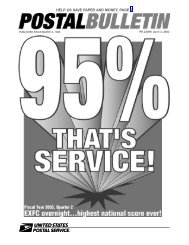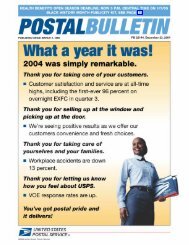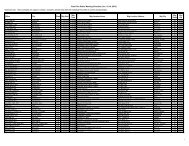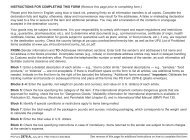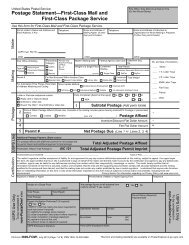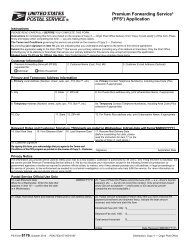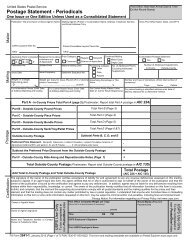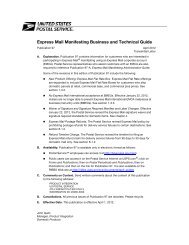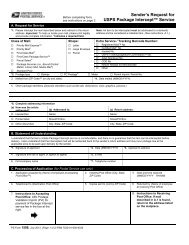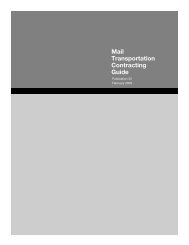birthright the homesteader the symbol of the unconquered
birthright the homesteader the symbol of the unconquered
birthright the homesteader the symbol of the unconquered
Create successful ePaper yourself
Turn your PDF publications into a flip-book with our unique Google optimized e-Paper software.
Materials Needed: U.S. Postal Service poster Oscar Micheaux: A Man Ahead <strong>of</strong> His Time, white construction<br />
paper, glue, black paper, cardboard boxes (or empty sanitized milk cartons), scissors, colored pencils, sturdy straws,<br />
scotch tape, adding machine paper (or long narrow strips <strong>of</strong> plain paper), computer, PowerPoint, reference<br />
materials, internet access, and printer<br />
The Reel Thing<br />
Read Oscar Micheaux’s biography.<br />
Cooperatively create a timeline <strong>of</strong> important<br />
events in Oscar Micheaux’s life. Students draw<br />
pictures depicting each event. Write short<br />
narratives to attach to <strong>the</strong> pictures. Students arrange<br />
<strong>the</strong>mselves in chronological order <strong>the</strong>n share <strong>the</strong>ir<br />
pictures and narratives. Glue <strong>the</strong> pictures in sequence<br />
to create a faux reel <strong>of</strong> film (glue pictures onto a<br />
long narrow strip <strong>of</strong> black paper with<br />
perforated edges).<br />
Bodacious<br />
Biographies<br />
Mr. Micheaux began his career by making silent, black-andwhite<br />
movies. Invite students to create <strong>the</strong>ir own “silent films”<br />
about famous African Americans.<br />
1 Have students choose one <strong>of</strong> <strong>the</strong>se famous African-American<br />
artists, writers, or performers that <strong>the</strong> U.S. Postal Service has<br />
honored with special stamps over <strong>the</strong> years: Marian<br />
Anderson, Louis Armstrong, Count Basie, Eubie Blake,<br />
Charles W. Chesnutt, Nat King Cole, John Coltrane, Paul<br />
Laurence Dunbar, Duke Ellington, Ella Fitzgerald, Erroll<br />
Garner, W.C. Handy, Coleman Hawkins, Billie Holiday, Howlin’<br />
Wolf, Langston Hughes, Mahalia Jackson, James P. Johnson,<br />
James Weldon Johnson, Scott Joplin, Leadbelly, Roberta<br />
Martin, Hattie McDaniel, Clyde McPhatter,<br />
Charles Mingus, Thelonious Monk,<br />
Materials Needed: paper, scissors, glue, colored pencils, crayons, markers, rulers, staplers, large<br />
white paper, tape, cardstock, computer, printer, Internet, videocams or flipcams, collection <strong>of</strong><br />
award-winning children’s books written by African-American authors<br />
Before We Begin<br />
Many popular children’s books have been made into movies (e.g. Charlotte’s Web, Cinderella,<br />
Beauty and <strong>the</strong> Beast, Winnie <strong>the</strong> Pooh, The Little Mermaid). Have students create Venn diagrams<br />
comparing and contrasting <strong>the</strong> book and movie versions <strong>of</strong> a children’s story. Which version<br />
did <strong>the</strong>y like best? Why? How do directors turn books into movies?<br />
Before making a movie, filmmakers create storyboards,<br />
or a series <strong>of</strong> pictures showing each scene in <strong>the</strong><br />
movie. This helps <strong>the</strong>m plan <strong>the</strong>ir camera shots,<br />
settings, and storylines. Storyboards are like comic<br />
book versions <strong>of</strong> <strong>the</strong> movie. Have students create <strong>the</strong>ir<br />
own cinema stories.<br />
1 Student teams select a quality book that celebrates<br />
African Americans. The American Library<br />
Association presents Coretta Scott King awards to<br />
African-American authors and illustrators each year.<br />
To see <strong>the</strong> list <strong>of</strong> winning books since 1970, please<br />
go to http://aalbc.com/books/related.htm. Select a<br />
quality children’s picture book from that list. The<br />
actual layout <strong>of</strong> <strong>the</strong> book constitutes a “storyboard”<br />
<strong>of</strong> sorts.<br />
2 To learn about animation, choose one action event<br />
from <strong>the</strong> story. Create a flip-book depicting that<br />
action. Using cardstock paper, draw a simple sketch.<br />
Repeat <strong>the</strong> same picture multiple times, changing<br />
Reali-TV<br />
How many students have seen video clips <strong>of</strong> real-life events on<br />
YouTube? How many watch reality TV shows that follow<br />
families through <strong>the</strong>ir daily activities? What makes <strong>the</strong>se shows<br />
so interesting? After securing parental and<br />
administrative permission, invite students to<br />
create <strong>the</strong>ir own reality mini-movies.<br />
Many <strong>of</strong> Mr. Micheaux’s novels and movies<br />
represented important events in his life. What are<br />
some <strong>of</strong> your students’ most important life<br />
experiences? Create Me TVs. First, students list <strong>the</strong>ir<br />
most important life events (birth, birth <strong>of</strong> siblings, first day <strong>of</strong><br />
school, etc.). On a long strip <strong>of</strong> paper, draw a series <strong>of</strong> evenly<br />
spaced pictures depicting each life event. Create miniature TVs<br />
(colorfully covered boxes with screen cut-outs on one side).<br />
Insert parallel straws above and below <strong>the</strong> screen’s opening.<br />
Carefully tape each end <strong>of</strong> <strong>the</strong> strip <strong>of</strong> pictures to each straw and<br />
roll in opposite directions until taut. Watch <strong>the</strong> TV show by rolling<br />
<strong>the</strong> top roller so <strong>the</strong> pictures advance. Students can narrate <strong>the</strong>ir<br />
slideshows. Create a mini-display <strong>of</strong> everyone’s Me TV at a<br />
learning center so students can enjoy one ano<strong>the</strong>r’s life stories.<br />
Jelly Roll Morton, Charlie Parker, E<strong>the</strong>l L. Payne, Ma Rainey,<br />
Otis Redding, Jimmy Rushing, Bessie Smith, Sister Rosetta<br />
Tharpe, Muddy Waters, and Josh White. Students might also<br />
be interested in visiting this site to research famous<br />
African-American filmmakers, directors, and film artists:<br />
http://www.liu.edu/cwis/cwp/Library/african/movies.htm.<br />
2 Create two-column charts with columnar headings “Q” and<br />
“A.” Write a series <strong>of</strong> research questions in <strong>the</strong> Q column<br />
and correlating answers in <strong>the</strong> A column.<br />
3 Create PowerPoint slideshows featuring <strong>the</strong> famous African<br />
Americans. Loop <strong>the</strong>m to create “silent films.” Volunteer<br />
students can play piano accompaniments just like <strong>the</strong>y used<br />
to do in <strong>the</strong> old <strong>the</strong>atres. Share during <strong>the</strong> Wee<br />
Cannes Film Festival.<br />
Daring Documentaries<br />
Oscar Micheaux explored controversial issues like racism in some <strong>of</strong> his films. O<strong>the</strong>r filmmakers make<br />
special films called documentaries to present <strong>the</strong>ir perspectives on controversial issues in an attempt to<br />
persuade people to take action. Invite students to create documentaries about <strong>the</strong>ir favorite “hot<br />
topics.” How can <strong>the</strong>y persuade o<strong>the</strong>rs to see <strong>the</strong> issue in a new light?<br />
1 Brainstorm a list <strong>of</strong> “hot topics” in <strong>the</strong> local community,<br />
region, state, country, or world. Topics might include global<br />
warming, environmental pollution, substance abuse, crime<br />
rate, homelessness, children in poverty, or healthful living.<br />
2 Form student teams with similar interests. Each team<br />
cooperatively conducts research about <strong>the</strong> selected topic.<br />
Students need to collect facts representing both sides <strong>of</strong><br />
<strong>the</strong> issue before taking a position.<br />
3 Assign production roles (e.g. director, narrator, actor, writer,<br />
videographer).<br />
4 After team members have collected all <strong>the</strong> information, <strong>the</strong>y<br />
<strong>the</strong> drawing slightly each time. Staple <strong>the</strong> pictures<br />
in order. When students flip through <strong>the</strong> book it<br />
will appear as if <strong>the</strong> drawing is animated. Movies<br />
are actually a series <strong>of</strong> rapidly-moving still shots.<br />
On old films people can see <strong>the</strong> individual frames.<br />
On digital films <strong>the</strong>y can see each frame by pausing<br />
<strong>the</strong> scene <strong>the</strong>n playing it in slow motion.<br />
3 Produce a cinematic version <strong>of</strong> <strong>the</strong> picture book.<br />
a. Using <strong>the</strong> book as a storyboard, identify<br />
important scenes and roles.<br />
b. Write a screenplay version <strong>of</strong> <strong>the</strong> book, complete<br />
with scripted lines, descriptions <strong>of</strong> settings and<br />
camera angles, and acting suggestions.<br />
c. Assign roles (director, cinematographer, actors,<br />
etc.).<br />
d. Practice, practice, practice.<br />
e. Tape. Edit.<br />
f. Save to share during <strong>the</strong> Wee Cannes Film<br />
Festival.<br />
1 Create storyboards depicting <strong>the</strong>ir usual daily activities.<br />
2 Identify appropriate targeted activities.<br />
3 Train students to use <strong>the</strong> video equipment.<br />
4 Partners videotape one ano<strong>the</strong>r.<br />
5 Students edit <strong>the</strong> mini-movies.<br />
6 Ensure <strong>the</strong> content is appropriate before sharing.<br />
7 Share during <strong>the</strong> Wee Cannes Film Festival.<br />
Materials Needed: “Little Abigail and <strong>the</strong> Beautiful Pony” (from <strong>the</strong> book<br />
Falling Up) by Shel Silverstein, Earrings by Judith Viorst, multiple newspaper and<br />
magazine advertisements, reference books, Internet, printer, flipcams or<br />
videocameras, <strong>the</strong>ater seating, red carpet, popcorn, beverages<br />
Before We Begin<br />
Read “Little Abigail and <strong>the</strong> Beautiful Pony” and/or Earrings. Ask students if <strong>the</strong>y have ever tried to<br />
persuade <strong>the</strong>ir folks to buy <strong>the</strong>m something or let <strong>the</strong>m do something. What persuasive strategies did<br />
<strong>the</strong>y use? What was <strong>the</strong> result? When people try to persuade one ano<strong>the</strong>r <strong>the</strong>y use propaganda<br />
devices such as name-calling (connecting a person or idea with a negative phrase), glittering generalities<br />
(euphemisms and glowing rhetoric), testimonial (famous person endorses idea or product), plain folks<br />
(average person believes it), card stacking (emphasize one perspective), and bandwagon (everyone else<br />
is doing it). To help students internalize <strong>the</strong>se concepts, ask <strong>the</strong>m to identify <strong>the</strong> propaganda devices<br />
used in provided advertisements and popular commercials.<br />
Materials Needed: white cardstock, computer,<br />
Internet access, printer, scissors, glue, envelopes, 1 cm. and<br />
1 in. graph paper, pencils, markers, crayons, full-size white<br />
construction paper, tape<br />
decide how <strong>the</strong>y want to try to persuade <strong>the</strong> audience to<br />
adopt <strong>the</strong>ir viewpoint using one <strong>of</strong> more <strong>of</strong> <strong>the</strong> propaganda<br />
devices described earlier.<br />
5 Create storyboards and/or screenplays—what visuals and<br />
words will <strong>the</strong>y use to promote <strong>the</strong>ir perspective?<br />
6 Practice, practice, practice!<br />
7 Train students to use video equipment so <strong>the</strong>y can record<br />
<strong>the</strong> team’s efforts.<br />
8 Cooperatively create short documentaries that present <strong>the</strong><br />
hot topic in a persuasive way.<br />
9 Share during <strong>the</strong> Wee Cannes Film Festival.<br />
Wee Cannes Film Festival<br />
Create a Wee Cannes Film Festival to celebrate students’ filmmaking efforts! Reserve <strong>the</strong> school’s<br />
<strong>the</strong>atre or create a classroom <strong>the</strong>atre by placing <strong>the</strong> chairs in rows, setting up a screen, and<br />
darkening <strong>the</strong> windows. Students might enjoy making popcorn to eat during <strong>the</strong> event. They could<br />
even have a pre-screening red-carpet event where <strong>the</strong>y interview <strong>the</strong> directors and lead actors in<br />
<strong>the</strong> films. Only give awards if every student receives dignified recognition <strong>of</strong> some kind.<br />
Celebrate what <strong>the</strong>y’ve learned about Oscar Micheaux and moviemaking magic!<br />
Create a series <strong>of</strong> learning stations celebrating movie making. Rotate student groups so that<br />
every child has an opportunity to do each activity.<br />
1 Celebrate African-American actors! Have students select<br />
one <strong>of</strong> <strong>the</strong>se black actors or ano<strong>the</strong>r black actor <strong>of</strong> <strong>the</strong>ir<br />
choice: Hattie McDaniel, Paul Robeson, Halle Berry, Denzel<br />
Washington, Will Smith, Jada Pinkett, Samuel L. Jackson,<br />
Eddie Murphy, Danny Glover, Whoopi Goldberg, Laurence<br />
Fishburne, Wesley Snipes, Cuba Gooding, Jr., Chris<br />
Rock, Lisa Bonet, Queen Latifah, Don Cheadle,<br />
Vin Diesel, or Chris Tucker.<br />
2 Use appropriate Internet sites to discover five facts<br />
and a picture <strong>of</strong> <strong>the</strong> actor.<br />
3 Glue <strong>the</strong> actor’s picture onto a piece <strong>of</strong> cardstock.<br />
Cut <strong>the</strong> cardstock into jigsaw puzzle pieces.<br />
4 Place <strong>the</strong> puzzle pieces into an envelope. Write five facts<br />
about <strong>the</strong> actor on <strong>the</strong> outside <strong>of</strong> <strong>the</strong> envelope.<br />
5 Students try to guess who’s who based upon <strong>the</strong> facts. They<br />
assemble <strong>the</strong> puzzles to see if <strong>the</strong>y were right.<br />
PHOTOS: Front: Portrait: Photo<br />
Courtesy <strong>of</strong> <strong>the</strong> State Archives <strong>of</strong><br />
<strong>the</strong> South Dakota Historical Society.<br />
Birthright: left, Phot<strong>of</strong>est; right,<br />
Courtesy Margaret Herrick Library,<br />
Academy <strong>of</strong> Motion Picture Arts<br />
and Sciences. The Homesteader: left,<br />
Library <strong>of</strong> Congress; right, Courtesy<br />
Film Program, School <strong>of</strong> <strong>the</strong> Arts,<br />
Columbia University. The Symbol <strong>of</strong><br />
<strong>the</strong> Unconquered: right, Phot<strong>of</strong>est.<br />
Back: Lights, Camera, Action: left,<br />
Courtesy Margaret Herrick<br />
Library, Academy <strong>of</strong> Motion<br />
Picture Arts and Sciences; right,<br />
Courtesy Film Program, School <strong>of</strong><br />
<strong>the</strong> Arts, Columbia University.<br />
Movie Magic: Courtesy Margaret<br />
Herrick Library, Academy <strong>of</strong><br />
Motion Picture Arts and Sciences.<br />
Terrific Titles: PhotoAssist, Inc.<br />
Credits image <strong>of</strong> Oscar Micheaux:<br />
Courtesy New York Public Library.<br />
Photo from Micheaux’s 1925<br />
film Within Our Gates. Posters<br />
advertising two o<strong>the</strong>r<br />
Micheaux films are below.<br />
Terrific Titles<br />
1 Select movies that feature black actors in a starring<br />
role. Create duplicate sets <strong>of</strong> title “tiles,” one letter per<br />
sheet <strong>of</strong> paper. Give one set <strong>of</strong> title tiles to each team <strong>of</strong><br />
students. Race to see who can unscramble <strong>the</strong> title rst.<br />
2 Students create cryptoquizzes using lm titles. Type<br />
<strong>the</strong> title into a word document. Change <strong>the</strong> original<br />
font to wingdings or webdings to convert <strong>the</strong> title into<br />
a secret code. Consider providing a key for one or two<br />
letters. Have student teams try to break <strong>the</strong> codes.<br />
3 Students create word searches including a lm’s title,<br />
actors, and key words about <strong>the</strong> storyline<br />
and setting. Use a puzzle-generator<br />
program or graph paper to create <strong>the</strong><br />
puzzles.<br />
4 Have students create promotions for<br />
<strong>the</strong>ir Me TVs, Cinema Stories,<br />
Bodacious Biographies, Reali-TVs or<br />
Daring Documentaries. Provide a<br />
forum for <strong>the</strong>m to display <strong>the</strong>ir<br />
posters or enact <strong>the</strong>ir <strong>the</strong>ater trailers.<br />
Biography and lesson plans created<br />
by Dr. Jacqueline Hansen, Murray<br />
State University. Project Manager:<br />
Jean Schlademan, Stamp Services,<br />
United States Postal Service.<br />
Design: Frank Schultz-DePalo,<br />
Corporate Communications,<br />
United States Postal Service.<br />
Photo Editor: Michael Owens,<br />
PhotoAssist, Inc. Copy Editor: Jeff<br />
Sypeck, PhotoAssist, Inc.<br />
OSCAR MICHEAUX<br />
Commemorative<br />
Stamp<br />
Art Director: Derry Noyes<br />
Illustrator: Gary Kelley<br />
First Day <strong>of</strong> Issue:<br />
June 2010<br />
Photo, left: Oscar<br />
Micheaux. Photo, above<br />
right: Oscar Micheaux’s<br />
star on Hollywood’s<br />
Walk <strong>of</strong> Fame.



